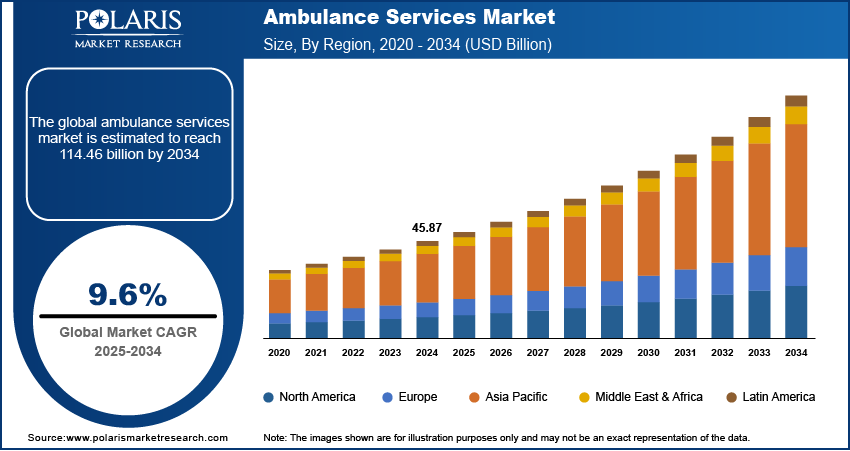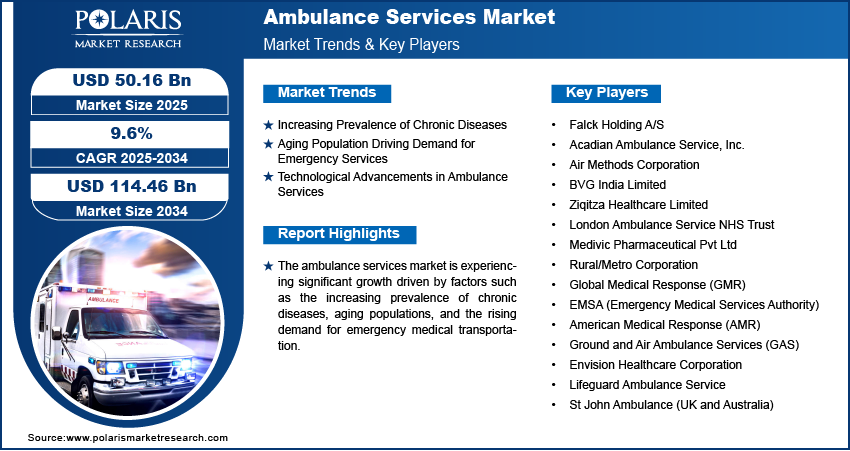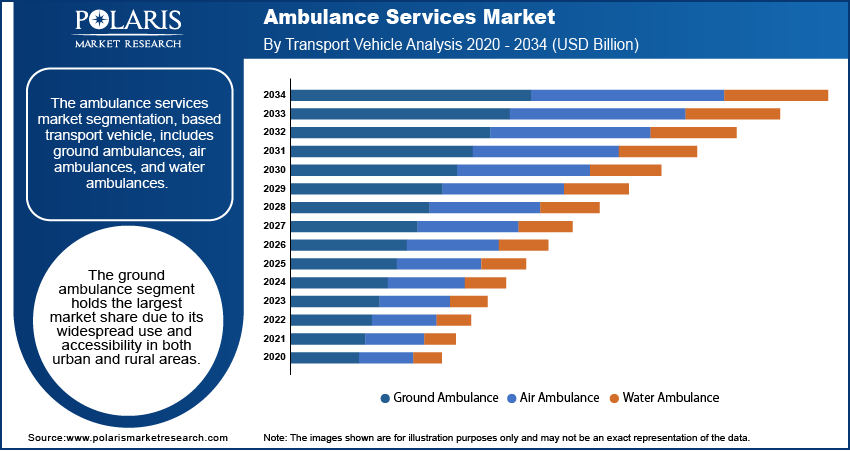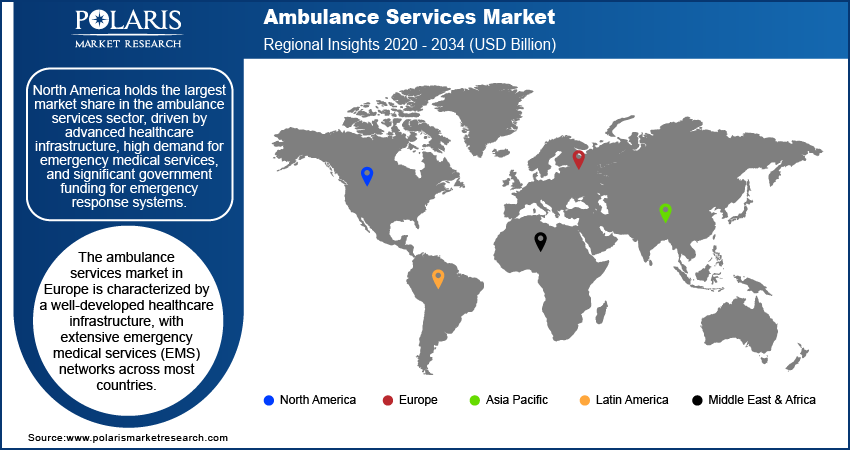
Ambulance Services Market Size, Share, Trends, Industry Analysis Report: By Transport Vehicle (Ground Ambulance, Air Ambulance, and Water Ambulance), Service Type, Equipment, Region (North America, Europe, Asia Pacific, Latin America, and Middle East & Africa) – Market Forecast, 2025–2034
- Published Date:Feb-2025
- Pages: 117
- Format: PDF
- Report ID: PM1892
- Base Year: 2024
- Historical Data: 2020-2023
Ambulance Services Market Overview
The ambulance services market size was valued at USD 45.87 billion in 2024. The market is projected to grow from USD 50.16 billion in 2025 to USD 114.46 billion by 2034, exhibiting a CAGR of 9.6% during 2025–2034.
The ambulance services market refers to the sector that provides emergency medical transportation and related services, including transport for patients requiring urgent medical care. This market is primarily driven by factors such as the increasing prevalence of chronic diseases, rising demand for emergency medical services due to aging populations, and advancements in medical technologies that improve the quality of care provided during transit. Additionally, the market is influenced by trends such as the integration of telemedicine and mobile health platforms into emergency response systems, as well as the expansion of private ambulance service providers in both developed and emerging economies. Growth in healthcare infrastructure and increasing government funding for emergency medical services further contribute to market expansion.

To Understand More About this Research: Request a Free Sample Report
Ambulance Services Market Dynamics
Increasing Prevalence of Chronic Diseases
The growing prevalence of chronic diseases, such as cardiovascular diseases, diabetes, and respiratory disorders, is a significant driver for the ambulance services market. Chronic conditions often require emergency care, leading to a higher demand for ambulance services for timely medical interventions. According to the World Health Organization (WHO), non-communicable diseases (NCDs) account for 71% of all global deaths, with cardiovascular diseases alone causing 31% of these deaths. This increase in the number of patients with chronic conditions has intensified the need for reliable and rapid medical transport. Ambulance services are crucial in delivering immediate care to these patients, especially those experiencing medical emergencies related to their chronic health issues.
Aging Population Driving Demand for Emergency Services
The aging global population is another major factor driving the ambulance services market growth. As the elderly population increases, so does the demand for emergency medical services, particularly for age-related health problems such as strokes, heart attacks, and falls. The US Census Bureau reported that by 2030, all baby boomers will be older than age 65, and one in every five residents will be retirement age. Older adults often require immediate medical attention in emergencies, placing pressure on ambulance services to be more responsive. The increase in life expectancy combined with the growing number of elderly individuals has consequently led to a greater need for emergency medical transport across various regions.
Technological Advancements in Ambulance Services
Technological advancements have significantly improved the efficiency and effectiveness of ambulance services, thereby supporting market growth. Innovations such as telemedicine, advanced life support systems, GPS tracking, and real-time data sharing between emergency medical teams and hospitals have enhanced the capabilities of ambulances. For instance, mobile health (mHealth) platforms have been integrated into ambulance services, allowing paramedics to consult with medical professionals remotely during transportation. A report from the National Institutes of Health (NIH) highlighted that the integration of telemedicine into emergency medical services improves patient outcomes and reduces overall healthcare costs. These advancements have not only improved patient care during transit but have also led to faster response times, making ambulance services an even more critical component of emergency medical care.

Ambulance Services Market Segment Insights
Ambulance Services Market Assessment by Transport Vehicle
The ambulance services market segmentation, based on transport vehicle, includes ground ambulances, air ambulances, and water ambulances. The ground ambulance segment holds the largest market share due to its widespread use and accessibility in both urban and rural areas. Ground ambulances are commonly equipped with advanced medical equipment and are the primary mode of transport for emergency medical services, making them essential for a wide range of emergency situations. This segment is also seeing growth due to improvements in healthcare infrastructure and the expansion of emergency response systems, particularly in developing regions. While air and water ambulances are crucial for reaching remote or inaccessible areas, the high operational costs associated with these services make them less prevalent compared to ground ambulances.
The air ambulance segment, however, is registering the fastest growth, driven by the increasing demand for quick medical evacuation services in cases where ground transportation is impractical due to geographical challenges. Air ambulances are particularly valuable in rural, mountainous, or disaster-stricken areas, where immediate medical attention is critical. The rise in healthcare needs, along with advancements in aviation technology, has fueled the demand for air ambulance services. Water ambulances, although vital in coastal or island regions, represent a smaller share of the market. Their growth is limited by regional factors, such as the availability of water-based routes and specialized infrastructure, but they remain an important component of the ambulance services sector in certain geographical areas.
Ambulance Services Market Evaluation by Service Type
The ambulance services market is segmented based on service type, including emergency services and non-emergency services. The emergency services segment holds the largest market share, primarily driven by the growing demand for urgent medical care. Emergency services are essential for providing immediate medical attention during life-threatening situations, such as heart attacks, strokes, and trauma cases. This segment benefits from the increasing incidence of medical emergencies, the rising prevalence of chronic diseases, and the need for rapid transportation to healthcare facilities. As a result, emergency services remain a critical component of the healthcare system, particularly in regions with aging populations and a higher frequency of medical emergencies.
The non-emergency services segment, while smaller in comparison, is also registering a significant growth. This is largely due to the increasing number of people who require transportation for medical appointments, routine checkups, and rehabilitation services, particularly in non-urgent cases. The segment's growth is also influenced by factors such as rising healthcare accessibility, the aging population, and the need for specialized patient transport services. Non-emergency ambulance services are gaining traction in regions where healthcare systems are expanding, and people are opting for more accessible, comfortable, and timely transport for non-critical medical needs.

Ambulance Services Market Regional Insights
By region, the study provides ambulance services market insights into North America, Europe, Asia Pacific, Latin America, and the Middle East & Africa. North America holds the largest market share in the ambulance services sector, driven by advanced healthcare infrastructure, high demand for emergency medical services, and significant government funding for emergency response systems. The region benefits from a well-established ambulance service network alongside technological innovations such as telemedicine and real-time data sharing, which enhance service delivery. The high prevalence of chronic diseases, aging populations, and the increasing incidence of medical emergencies further contribute to the demand for ambulance services. Additionally, the presence of a large number of private ambulance providers in the region has expanded service availability, ensuring rapid response times and broad coverage across both urban and rural areas. Other regions such as Europe and Asia Pacific are also witnessing growth, driven by improving healthcare systems and the rising need for emergency care, though they are not as dominant as North America in terms of market share.
The ambulance services market in Europe is characterized by a well-developed healthcare infrastructure, with extensive emergency medical services (EMS) networks across most countries. The market is driven by factors such as the increasing demand for emergency care due to aging populations and the rising prevalence of chronic diseases. European countries have robust public health systems that fund and regulate ambulance services, with an emphasis on efficiency and high-quality care. Additionally, advancements in emergency medical technology, including telemedicine and mobile health applications, are contributing to the growth of the market. However, the growth rate in this region is somewhat tempered by the presence of efficient public health services and the saturation of the market in many Western European countries.
Asia Pacific is witnessing significant growth in the ambulance services market, driven by rapid urbanization, increased healthcare access, and improving medical infrastructure in emerging economies. Countries such as China and India, with their large populations and expanding healthcare systems, are experiencing rising demand for both emergency and non-emergency ambulance services. The growing prevalence of chronic diseases and medical emergencies, combined with the need for timely medical interventions, is fueling this growth. Moreover, technological advancements in mobile health and the increasing adoption of air ambulances in remote and rural areas are also contributing to the market expansion. While some countries in the region still face challenges related to healthcare accessibility and ambulance service coverage, the overall trend is toward significant growth, with governments and private players investing in EMS capabilities.

Ambulance Services Market Key Players and Competitive Insights
The ambulance services market comprises several key players operating across various regions. In the US, prominent companies include Envision Healthcare Corporation, Falck Holding A/S, Acadian Ambulance Service, Inc., and Air Methods Corporation. In India, BVG India Limited and Ziqitza Healthcare Limited are notable providers. The UK's London Ambulance Service NHS Trust is a significant entity in Europe.
These companies offer a range of services, including emergency and non-emergency medical transportation, advanced life support, and patient care. They utilize various transport modes such as ground ambulances, air ambulances, and water ambulances to meet diverse patient needs. The competitive landscape is influenced by factors such as service quality, response times, technological advancements, and geographic coverage. Companies are focusing on expanding their service offerings, enhancing operational efficiency, and adopting innovative technologies to improve patient outcomes and gain a competitive edge.
The ambulance services industry is characterized by both local and international players, each contributing to the overall growth and development of ambulance services. Strategic partnerships, mergers, and acquisitions are common strategies employed to strengthen market position and expand service capabilities. The presence of multiple players fosters a competitive environment, encouraging continuous improvement and innovation within the industry.
Envision Healthcare Corporation is a major player in the ambulance services market, providing emergency medical transportation across the US. The company offers both ground and air ambulance services, focusing on delivering emergency care and medical transportation for individuals in need. Envision Healthcare operates in various regions and provides services that include advanced life support and patient care.
Falck Holding A/S is another key player in the ambulance services market, with a presence in several countries worldwide, including the US, Denmark, and Sweden. The company offers a broad range of services, including emergency medical transportation, non-emergency patient transport, and healthcare solutions. Falck’s services are integrated with healthcare systems to provide rapid and effective emergency care.
List of Key Companies in Ambulance Services Market
- Falck Holding A/S
- Acadian Ambulance Service, Inc.
- Air Methods Corporation
- BVG India Limited
- Ziqitza Healthcare Limited
- London Ambulance Service NHS Trust
- Medivic Pharmaceutical Pvt Ltd
- Rural/Metro Corporation (Acquired by American Medical Response)
- Global Medical Response (GMR)
- EMSA (Emergency Medical Services Authority)
- American Medical Response (AMR)
- Ground and Air Ambulance Services (GAS)
- Envision Healthcare Corporation
- Lifeguard Ambulance Service
- St John Ambulance (UK and Australia)
Ambulance Services Market Developments
- November 2024: Envision Healthcare announced its collaboration with local government agencies to improve emergency response times through the deployment of additional ambulances and integration of advanced medical technology in response to increasing demand for urgent care.
- October 2024: Falck introduced a new fleet of advanced ambulances in its European operations, aimed at enhancing the efficiency of emergency medical services by incorporating modern medical equipment and digital health solutions to assist paramedics during patient transport.
Ambulance Services Market Segmentation
By Transport Vehicle Outlook
- Ground Ambulance
- Air Ambulance
- Water Ambulance
By Service Type Outlook
- Emergency Services
- Non-Emergency Services
By Equipment Outlook
- Advanced Life Support (ALS) Ambulance Services
- Basic Life Support (BLS) Ambulance Services
By Regional Outlook
- North America
- US
- Canada
- Europe
- Germany
- France
- UK
- Italy
- Spain
- Netherlands
- Russia
- Rest of Europe
- Asia Pacific
- China
- Japan
- India
- Malaysia
- South Korea
- Indonesia
- Australia
- Vietnam
- Rest of Asia Pacific
- Middle East & Africa
- Saudi Arabia
- UAE
- Israel
- South Africa
- Rest of Middle East & Africa
- Latin America
- Mexico
- Brazil
- Argentina
- Rest of Latin America
Ambulance Services Market Report Scope
|
Report Attributes |
Details |
|
Market Size Value in 2024 |
USD 45.87 billion |
|
Market Size Value in 2025 |
USD 50.16 billion |
|
Revenue Forecast by 2034 |
USD 114.46 billion |
|
CAGR |
9.6% from 2025 to 2034 |
|
Base Year |
2024 |
|
Historical Data |
2020–2023 |
|
Forecast Period |
2025–2034 |
|
Quantitative Units |
Revenue in USD billion and CAGR from 2025 to 2034 |
|
Report Coverage |
Revenue Forecast, Market Competitive Landscape, Growth Factors, and Industry Trends |
|
Segments Covered |
|
|
Regional Scope |
|
|
Competitive Landscape |
|
|
Report Format |
|
|
Customization |
Report customization as per your requirements with respect to countries, regions, and segmentation. |
How is the report valuable for an organization?
Workflow/Innovation Strategy
The ambulance services market has been segmented into detailed segments of transport vehicle, service type, and equipment. Moreover, the study provides the reader with a detailed understanding of the different segments at both the country and regional levels.
Growth/Marketing Strategy
The growth strategy for companies in the ambulance services market focuses on expanding service coverage, enhancing operational efficiency, and adopting advanced technologies. Players are increasingly investing in modernizing their fleets with state-of-the-art medical equipment and integrating telemedicine for improved patient care during transit. Strategic partnerships with hospitals, healthcare providers, and government agencies are being formed to expand reach and improve service delivery. Additionally, there is a growing focus on geographic expansion, particularly in emerging markets, to meet the rising demand for emergency medical services. Marketing efforts are also geared towards promoting reliability, response times, and the quality of patient care.
FAQ's
? The ambulance services market size was valued at USD 45.87 billion in 2024 and is projected to grow to USD 114.46 billion by 2034.
? The market is projected to register a CAGR of 9.6% during the forecast period, 2025-2034.
? North America had the largest share of the market.
? The ambulance services market comprises several key players operating across various regions. In the US, prominent companies include Envision Healthcare Corporation, Falck Holding A/S, Acadian Ambulance Service, Inc., and Air Methods Corporation. In India, BVG India Limited and Ziqitza Healthcare Limited are notable providers. The United Kingdom's London Ambulance Service NHS Trust is a significant entity in Europe.
? The ground ambulance segment accounted for the larger share of the market in 2024.
? The emergency services segment accounted for the larger share of the market in 2024.
? Ambulance services refer to the transportation of individuals who require medical attention due to emergencies or non-emergency situations. These services involve the use of specially equipped vehicles, such as ground ambulances, air ambulances, or water ambulances, to deliver patients to healthcare facilities or provide medical care during transit. Ambulance services include emergency medical transport for conditions like heart attacks, strokes, or accidents, as well as non-emergency transport for individuals needing medical appointments or routine care. These services are typically staffed by trained medical personnel such as paramedics or emergency medical technicians (EMTs) who provide life-saving interventions while en route.
? A few key trends in the market are described below: Integration of Telemedicine: Increasing use of telemedicine for remote consultation during transport, improving patient care and outcomes. Technological Advancements: Adoption of advanced medical equipment in ambulances, such as portable ventilators and real-time monitoring systems. Use of Air Ambulances: Growing demand for air ambulances in remote or difficult-to-reach areas for quicker emergency responses. Private Ambulance Services Expansion: Rise in private ambulance providers, offering enhanced services and reducing the burden on public systems.
? A new company entering the ambulance services market could focus on leveraging advanced technology to differentiate itself, such as integrating telemedicine for real-time consultations during transport and implementing GPS tracking for efficient route optimization. Offering specialized services, such as air ambulances for remote areas or non-emergency medical transportation, could also help tap into underserved markets. Additionally, ensuring fast response times and focusing on patient comfort and care during transport would provide a competitive edge. Partnering with healthcare providers and government agencies to ensure seamless coordination and service expansion could further strengthen market positioning. Emphasizing quality and reliability in service delivery would also be key to building customer trust.
? Companies manufacturing, distributing, or purchasing Ambulance Services and related products, and other consulting firms must buy the report.
